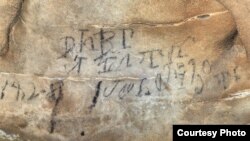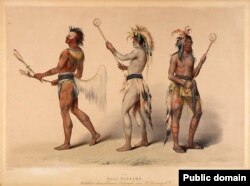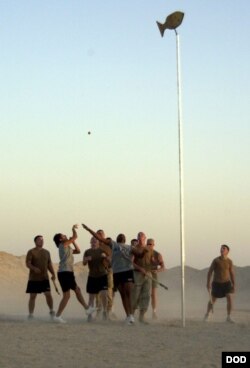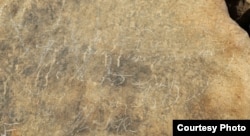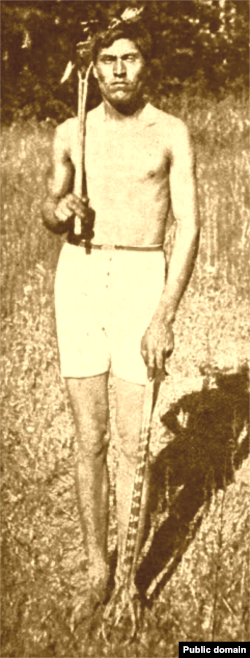April 30, 1828: A group of Cherokee men gathered inside a cave near present-day Fort Payne, Alabama, for a secret ritual before a game of stickball. To record the event, team leaders inscribed words and phrases on the cave walls, using a writing system invented by the Cherokee visionary Sequoyah.
In a recent article in the British academic journal Antiquity, “Talking Stones: Cherokee syllabary in Manitou Cave, Alabama,” Cherokee and non-Native scholars interpret the inscriptions, explaining the significance of the ancient game.
“The early Cherokee were really smart,” said Beau Duke Carroll, co-author and member of the Eastern Band of Cherokee in North Carolina. An archaeologist for the tribe’s Historic Preservation Office, Carroll explained why stickball is referred to as “the little brother to war.”
“They would recognize that if somebody was killed in war, whatever skills he had, whatever service he was to tribe and family, wouldn’t be provided anymore,” he said. “They realized they would rather find another way to solve conflicts over land or other disputes — and I’m sure opposing tribes and communities felt the same way.”
That 'other way' was stickball, one of the roughest sports on the planet.
The rules vary, sometimes from game to game, but follow general lines: Team members, historically wearing only loin cloths and today, shorts, carry a pair of long wooden sticks with woven cups at one end to scoop up and drive a small ball toward goals at either end of the playing field.
In one variation played by the Cherokee Nation in Oklahoma, players score points by striking the wooden effigy of a fish which tops a 7.5 meter (25-foot) pole at the center of the field.
Players may not use their hands to catch the ball, but they may use them to block and tackle opponents. Because players wear no protective gear or shoes, injuries are common—"scratches and bruises at the very least,” said Carroll.
To watch modern players in action, see video below:
“Stickball isn’t just a game,” Carroll added, “it’s a ceremony itself.”
Leading up to a match, players participate in secluded prayer, guided by a religious leader, to weaken their opponents and ensure victory. Though these rituals have been described by historic ethnographers, Carroll only addresses a few of them, as others are considered sacred and not to be divulged.
“Basically, they performed the same rituals as they would before going to war,” he said. Part of the ceremony, called “going to water,” involved emotional and physical cleansing by water before, during and after the game.
“It’s a ritual that’s part of everyday life — even today,” he said.
By 1828, the Cherokee in Alabama had already been squeezed out of their original homeland in North Carolina and were under great pressure by the U.S. government, missionaries and Christianized tribe members to give up traditional beliefs and ceremonies.
The stakes were high if they were caught performing ceremonies. “If they decided that you weren’t being Christian enough, then they'd pull their support and your whole family would starve,” said Carroll.
The Manitou Cave was the ideal place to perform illicit ceremonies: it was secluded; it was also spiritually significant, considered a portal to the underworld, inhabited by the spirits of the ancestors and other supernatural beings.
The inscriptions, either etched in charcoal or scratched into a charcoal-darkened surface, appear throughout the cave.
One set identifies the date of the game. Another identifies the players as “those that have blood come out of their nose and mouth,” suggesting they were faring badly in the game. This set of inscriptions is signed in English, by the team leader, “Richard Guess,” believed to be Sequoyah’s son.
The inscriptions in Manitou Cave are important, say the authors, because they offer a window into a moment in time when Cherokee culture was clinging to survival. They are also important because while it was non-Native scholars who first discovered the inscriptions, it was Cherokee scholars who gave them context and meaning.
Which teams were playing — and who emerged as the winner — is lost to history. Two years after the game, Congress passed the Indian Removal Act, and in 1838, government agents forcibly removed thousands of Cherokee living east of the Mississippi River westward to what is today Oklahoma. Several thousand died along the “Trail of Tears” of exposure, disease or starvation.
A small group of Cherokees from whom Carroll is descended managed to remain in North Carolina and are today known as the Eastern Band of Cherokee Indians, based on the 23,000-hectare (57,000-acre) Qualla Boundary.
The Cherokee Nation and the United Keetoowah Band of Cherokee Indians, the only other federally-recognized Cherokee tribes, are both based in Oklahoma — and both play stickball today.
Europeans adopted the game, which has evolved into today’s Lacrosse. Unlike their predecessors, lacrosse team members have defined positions and wear heavy protective gear.
“They had to change it,” said Carroll, “to better suit people who couldn’t stand getting hurt.”




